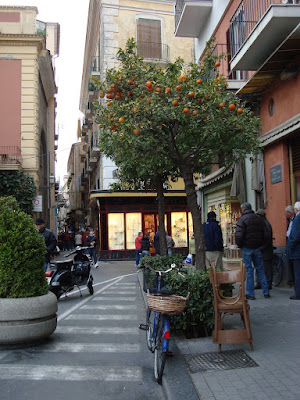Naples, for the daring.

Naples, or Napoli
Reading this, you might be wondering what is there to do in Naples, besides getting potentially pick-pocketed or stepping on dog droppings (since no one here picks up after their dogs).
Well, the less I say about Naples the better, only because to the unaware traveler who has never been to Italy before, you might get a negative impression of the country if Naples is the first place you visit. I haven’t experienced this kind of traffic and heart-propelling jay walking since Vietnam back in 2000. And in some ways, Naples is the same as Saigon, mainly in the traffic, the mopeds running on streets and sidewalks, the scarcity of street lights, and the trash (in piles which kind of remind me of Manhattan but bereft of any of the nightlife and convenience of wide sidewalks to bypass it). There was also the complete absence of lanes, made apparent to me when our taxi driver drove in the dead middle of the road. You need to be daring to effectively manipulate the road and traffic here and it somehow made me glad that I didn't have a car (the rare instance where I'm actually happy about that fact).
Some will say this environment is an indication of character and the real atmosphere of non-tourist filled Italy, a place where very few spoke English and when you go out to eat, it's better to just mime writing for "bill" or pointing to the cuisine you want. Yet for me, I wish I was back in Florence, if only to not have to fear crossing the road. But the pizza ended up tasting amazing (the first time I actually had a "Pizza Margherita" that I actually liked) and the hostel was clean.
Though we stayed in an 8-bed room, we ended up making friends with quite a number of people, including two students from Wisconsin, a German, a Scot, and the friendly hostel owners. We all bonded over a shared love of “The Simpsons” and Nepalese pizza.

The reason we went to Naples in the first place was Pompeii (and from what I could gather at the train station, it's the primary reason why anyone would go to Naples). The ancient city (apparently considered a real life Sodom) was a lot less preserved that I had actually envisioned. What I had thought were going to be completely intact houses were only ruins, long roads worth of destroyed walls, broken columns, and empty archways (though the houses that were completely intact gave you almost a haunted feeling when stepping within them, almost as if the ghosts were still looking). My guidebook considerately described Pompeii as "an archaeologist's dream" and somehow, the title seems fitting.

We also had a small excursion to Sorrento, or what I like to call, land of lemons since there were no only lemon and orange trees growing on the sidewalks, but shops which sold lemon kitchen ware, clothes, merchandise, alcohol, and chocolate. Try the lemoncello (lemon alcohol) if you are there, if nothing more than to see what all the fuss is about (what with all the lemon trees). It's both a really tart and a really bitter experience, which was actually strangely appealing though not something you can drink all of the time. We also sampled some chocolates within a lemon-flavored shell. Who knew lemons and chocolates actually went well together? Though definitely not something I would want all the time (I'll stick with Galaxy).
So, despite the unsavory reputation that Naples has, the wonderful pizza and trip to Pompeii was well worth the excursion. Not to mention that Naples airport boasted a spectacular view of the surrounding mountainsides (and you were actually driven out to the plane like in so many old movies).

Arrivederci Italia!
Tips:
- Watch out for dog droppings
- Beware the mopeds when you are crossing the street, they never look like they are going to slow down for you
- Be prepared to jay-walk a lot since there are rarely any pedestrian street lights
- When walking in Naples at night, walk with a friend since it does give off a seedy vibe come dark
- Eat lots and lots of pizza to warrant actually going to Naples (they did invent pizza after all)
- Pizza "Salami piccante" = pepperoni pizza, I never realized that pepperoni was not really an Italian word until I got to Italy, go figure.




























